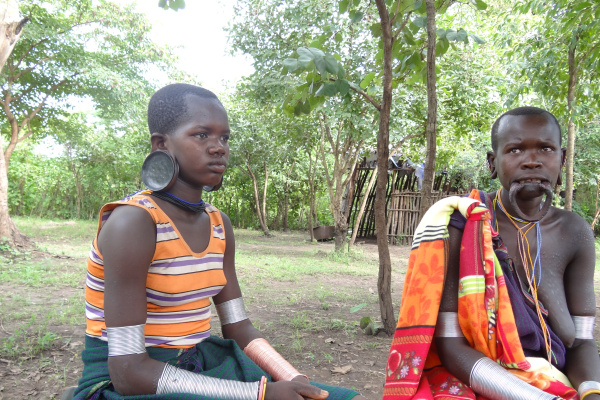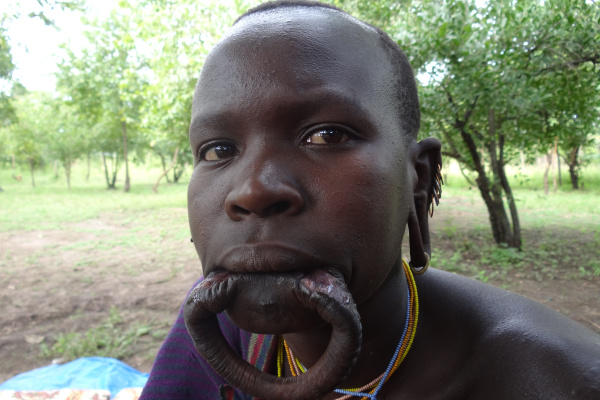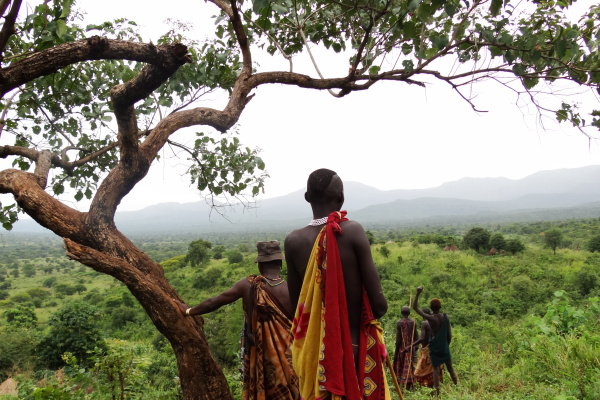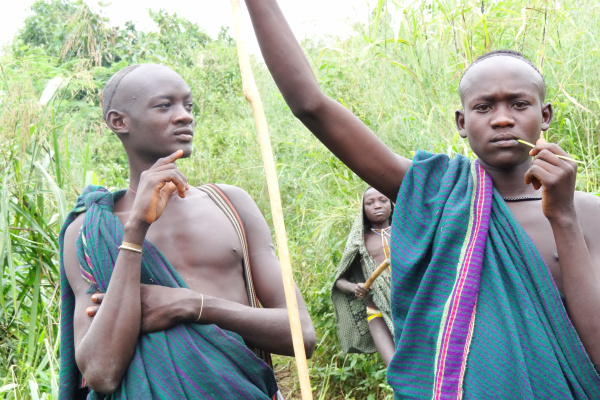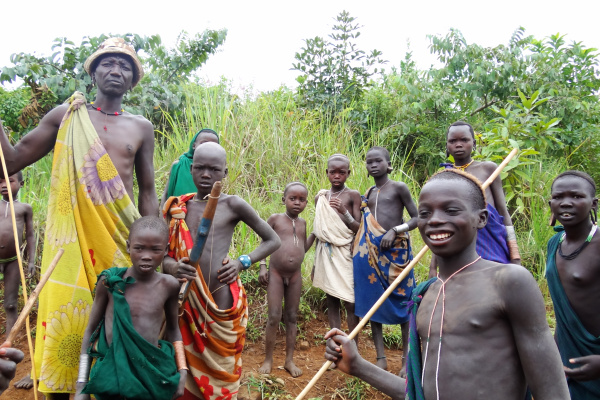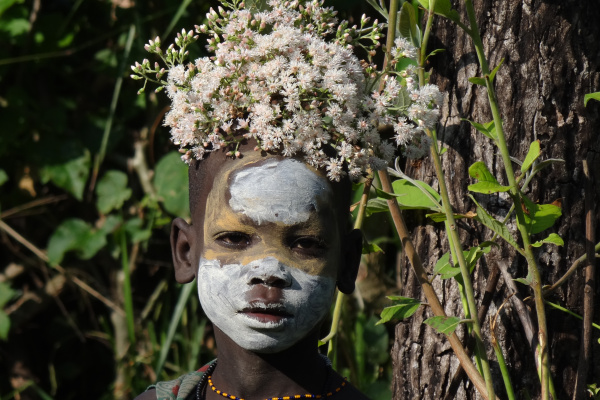The Surma or Suri people
Presentation
Indifferent to any religion, without organized political power, the Surma live in self-sufficiency, isolated in their wild mountains covered with forests and savannahs.
According to oral tradition, the Surma originated from the Lower Omo region north of Lake Turkana, even if their language is more reminiscent of Nilotic ancestry. They vigorously defend themselves from any kinship with the Mursi and the Bodi, although they share many customs and speak the same language as them. On the other hand, they belong to the same group as the Balé, people of the Akobo River region, straddling Ethiopia and Sudan, but differ in one essential point: livestock.
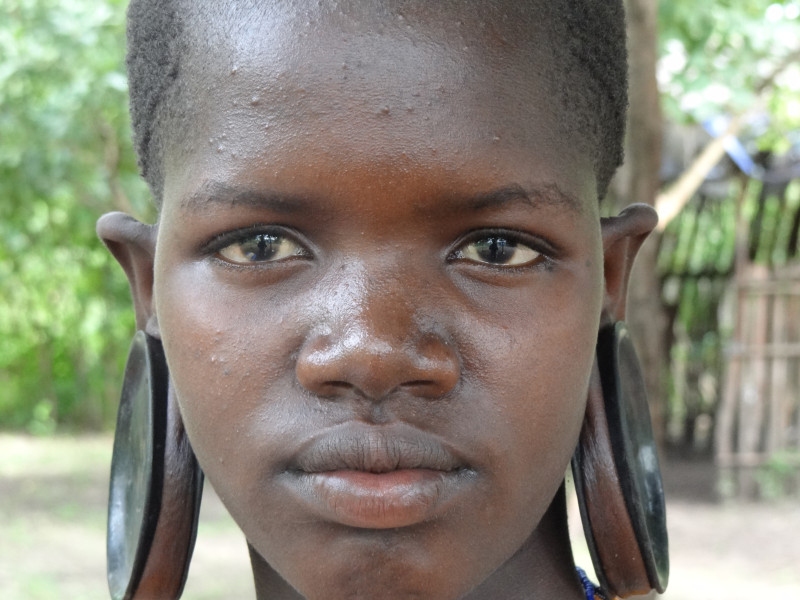
Surma a life outside of time
The Surma, to be forced to cultivate the land too, proudly declare themselves pastors. An anthrax epidemic in the 1970s wiped out all their herds at once, reducing them to poverty. Although they were forced to grow sorghum and corn to survive, they did not change their value system in any way, and continued to consider cattle as a symbol of wealth, nobility and social status.
The trade in gold, which they found in quite large quantities in the region, allowed them to replenish their livestock and to discover, on this occasion, that the yellow metal could also be used to obtain firearms and ammunition. in neighboring Sudan, perpetually in civil war. Armed with guns, how easy it became for them to obtain livestock! The raids among the Nyangatom, their long-time enemies, became more numerous. For almost twenty years now, the Surma have been at war with their southern neighbors.
The Surma enjoy de facto political autonomy. They pay no taxes, and self-administer without any external interference. In truth, Surma territory was never truly conquered. Annexed to the Ethiopian Empire in 1897, it came under Italian domination a few decades later without any change. The communist regime of Mengistu was no more successful, so that even today the Surma villages are only accessible after hours of walking along paths overgrown with vegetation.
There are no roads, no schools, no hospitals. The mountains between the course of the Kibish and the escarpment which dominates the Omo valley are among the most remote and inaccessible areas of the entire continent. Rain — nearly six hundred millimeters per year — falls in spring and summer in the form of violent downpours. During the dry season, average temperatures never drop below 33°C.
The women pound the grains, which they will then grind to produce a fine flour. Other grains will be mixed with water and then left to ferment until they become delicious alcoholic beverages, thick on the palate and vaguely reminiscent of our local beers. The young Surma are entrusted with the care of small livestock like goats while awaiting the rites of passage into adulthood, which will then allow them to watch over and protect the cattle herds from predators or neighboring tribes. Villages typically consist of about thirty thatched-roof huts built on hillsides. Fields are arranged around the village, and a village square is reserved for gatherings, discussions, and festivities.
Protected by this harsh and remote environment, the Surma have preserved the traditions of their ancestors. The last census counted around 20,000 individuals. The Surma have no chiefs. Their system, devoid of a centralized political structure capable of imposing coercive will, is described by ethnologists as “acephalous” or “segmented.” The family, including wives and children, is the basic unit of their organization. The men, who are generally polygamous, take on tasks far from the home. They defend their territory, take care of the cattle herds kept in enclosures near the grazing areas, sometimes located more than a day's walk from the village. Hunting small and large animals is a significant source of food for them, and poaching in the nearby Omo National Park is among their usual practices.
Their economic independence and the absence of strict moral rules give them a certain freedom. Premarital sex is common practice, and mothers teach their daughters how to navigate their romantic affairs and the most effective contraceptive methods. Among the Surma, physical beauty is of paramount importance. Everyone takes great care of their appearance, with a special emphasis on body paint. Hairstyles are another key element of the pride of Surma warriors. They shave their heads with razor blades, leaving some decorative lines.
As with the Mursi, glass bead necklaces and metal bracelets, along with the labret, are essential items of female seduction. Shaped from wood or clay, this lip plate is round or trapezoidal and can reach a considerable diameter. With her balsa labret and pierced ears, the Surma woman represents a desirable value.
Voici la traduction en anglais du second texte :
---
For men, it is customary to perform scarifications on the chest, abdomen, or arms to honor their bravery. The scars resulting from stick fights, known as Donga, leave indelible marks that recount heroic deeds and the courage displayed.
During the Donga, a jousting match with wooden sticks, the opponents face off two by two. The violence of the confrontations compels participants to protect their heads and joints with specially braided plant fibers. While the winner awaits his next opponent, the defeated leaves the arena with honors, as mere participation is a sign of honor and courage. In the end, there will be a final victor, who will be triumphantly carried on a stretcher made of poles. He will then be presented by his peers to the group of marriageable young women, who will choose among themselves the one who will propose marriage to him.
Strength, skill, and elegance are required, and very often these combats serve as a pretext to settle old disputes. After a while, the excitement from the sight of blood and the alcohol consumed reaches its peak, and the atmosphere often becomes tense; the tournament sometimes ends in deaths. These fights between inhabitants of the same village or allied villages serve as an outlet for the aggression of young men in the first two age groups, between 16 and 32 years old. In these fights, all blows are allowed, but killing one’s opponent is forbidden. If this accidentally happens, the offender is banished from the village along with his entire family. Additionally, he must give a young girl to the victim’s parents as compensation for the life taken.
Like the Maasai and other pastoral peoples of East Africa, the Surma have a diet adapted to the harsh local conditions, based on milk and fresh blood, their only sources of animal protein. Their horned cattle, indeed their only wealth, are too precious to be eaten, so they are content to periodically draw a little blood. To do this, they shoot a fine arrow at close range into the animal's jugular vein to generously extract the vital liquid.
The Surma are also known for their floral adornments, much to the delight of photographers. But behind these flowers that enhance them, the reality is not as flourishing. Do they complain? No, as if living in this wild nature far from all modernity brings them everything they expect from life. A people worthy of being met.


